Nick Polyak and I are proud to announce that our 5th book is just about on the marketplace! Leading for Tomorrow’s Schools Today, Bloomsbury Academic Press, will be available October 16, 2025 – it’s available for

Leading for Tomorrow’s Schools Today
preordering today directly from the publisher – visit https://www.bloomsbury.com/us/leading-for-tomorrows-schools-today-9781475874877/
Here is a cool, “AI” Generated Video that took the preface and introduction and made a 3-minute overview – HT to Dan Fitzpatrick for the tip to use Symvol.io
https://app.symvol.io/videos/file-1fd5 (link) or see the embed below
Overview
Leading for Tomorrow’s Schools Today is a forward-thinking guide for educational leaders navigating the rapidly changing landscape of 21st-century schools. Authored by seasoned superintendents Mike Lubelfeld & Nick Polyak, this book offers practical strategies and insightful reflections on how to lead effectively in times of change and uncertainty. Drawing on years of experience and a deep understanding of the educational field, the  authors provide a roadmap for fostering growth, embracing innovation, and driving meaningful transformation in schools. The book emphasizes the importance of change and growth planning, highlighting proven approaches to cultivating a positive school culture, empowering teachers, and enhancing student outcomes. With a focus on both the challenges and opportunities that lie ahead, Leading for Tomorrow’s Schools Today equips leaders with the tools and mindset necessary to create learning environments that prepare students for success in a complex and dynamic world. This book is an essential resource for current and aspiring school leaders committed to shaping the future of education.
authors provide a roadmap for fostering growth, embracing innovation, and driving meaningful transformation in schools. The book emphasizes the importance of change and growth planning, highlighting proven approaches to cultivating a positive school culture, empowering teachers, and enhancing student outcomes. With a focus on both the challenges and opportunities that lie ahead, Leading for Tomorrow’s Schools Today equips leaders with the tools and mindset necessary to create learning environments that prepare students for success in a complex and dynamic world. This book is an essential resource for current and aspiring school leaders committed to shaping the future of education.
Tom Murray wrote the Foreword!
Glenn Robbins, Zandra Jo Galván, Gladys Cruz, and Jeff Dillon wrote Vignettes!
Table of Contents
Foreword by Tom Murray
Preface
Acknowledgments
Introduction
List of Tables & Figures
Section 1: Leadership is Change
Chapter 1: Cultivating Change
Chapter 2: Selection of Staff, Who, How, and How Long?
Voices from the Field: Leading Transformation in a VUCA World: A Progressive Vision for Brigantine Public School District by Glenn Robbins, Superintendent
Section 2: Go Where the Smart People Are – Learning From Others
Chapter 3 : Networks and Professional Organizations
Chapter 4: Language Matters
Voices from the Field: My Journey of People-Centered Leadership as Superintendent by Dr. Zandra Jo Galvan
Section 3: You Can Do It
Chapter 5: We’re Not Broke, We’re Broken
Chapter 6 Transformation: Flip the Mindset
Voices from the Field: Expanding Pathways to Success by Gladys I. Cruz
Section 4: Change Faster – Embrace Your Context – Revolutionary Change
Chapter 7: Bomb Threats and Social Media
Chapter 8: Artificial Intelligence & Innovation
Voices from the Field: The Student’s Bill of Rights by Jeff Dillon,
Conclusion
References
Appendix A Interviews from the Pandemic Era-Use Case for Generative AI and Leadership
Appendix B (Teach AI Guidance)
Appendix C Listing of Generative Artificial Intelligence Tools Used Throughout this Book
About the Authors
We’re grateful to our testimonial endorsers too!!
Thank you Luvelle, Joe, Courtney, Chris, & Lupita!!
The vast amount of professional experience and talent that exists with Mike Lubelfeld and Nick Polyak is on full display in Leading for Tomorrow’s Schools Today. They inspire me and others through research, practical frameworks, and case studies that reveal strategic and successful approaches to innovating in school. Their text should be required reading for any leader wishing to be highly effective with change management and the implementation of generative artificial intelligence into their practices.
Luvelle Brown
Superintendent, Ithaca City School District
Founder/CEO Love2Achieve LLC.
Leading for Tomorrow’s Schools Today provides a rich blend of real-world experience and practical insights from two seasoned superintendents who have navigated and led change in schools for nearly 60 years. Through compelling stories, Mike and Nick emphasize how creating supportive conditions and fostering innovation leads to long-term success. The book offers lessons that extend beyond education, making it a valuable read for leaders in all fields of leadership. Mike and Nick provide a clear framework for understanding and managing the complexities of organizational change. This is an inspiring and practical guide for anyone looking to lead purposefully and prepare everyone in their organization for the future.
Joe Sanfelippo
Superintendent, Author, Speaker, Wisconsin
In Leading for Tomorrow’s Schools Today, Polyak and Lubelfeld delve deep into the realities of leadership, embracing the chaos and resistance that often accompany the drive for change. They do not shy away from the difficulties but instead confront them head-on, offering a wealth of success stories that illuminate their points, offering real-world examples of how visionary leadership can yield remarkable results and a candid exploration of the obstacles leaders face. Polyak and Lubelfeld urge us to adapt and be flexible, framing leadership as an evolving journey rather than a destination.Their approach is both pragmatic and inspirational, thought-provoking yet practical, encouraging leaders to view challenges as opportunities for growth rather than insurmountable barriers. Leading for Tomorrow’s Schools Today is a vital read for anyone in educational leadership.
Courtney Orzel
Superintendent
Lemont Bromberek Combined School District 113A, Illinois
Leading for Tomorrow’s Schools Today by Nick Polyak and Michael Lubelfeld offers a robust framework that has become a cornerstone for how we approach change management in our AASA Redefining Ready work. The practical tools and insights in this book have directly supported our mission to redefine what it means for students to be college, career, and life-ready.
Polyak and Lubelfeld’s CHANGE Framework—Challenge the Status Quo, Have Open Conversations, Adapt and Be Flexible, Navigate Obstacles, Generate a Shared Vision, and Enjoy the Journey—is particularly valuable in guiding school leaders through the transformation required in our AASA initiatives. We’ve applied this framework to help districts across the country rethink outdated measures of success, shifting focus to real-world indicators such as career pathways, internships, and dual credit programs, which better prepare students for life after graduation.
Their use of the Satir Change Model has given us a structured process for managing resistance and chaos that inevitably arise when implementing new readiness metrics. This model provides the emotional and psychological scaffolding that leaders need to navigate through disruption and arrive at a new, more equitable status quo—one where students are assessed not just by test scores, but by their demonstrated readiness for the future.
Additionally, their call for embracing AI and innovation mirrors the cutting-edge work we are doing in Redefining Ready to prepare students for the future workforce. Their emphasis on future-focused leadership is critical as we guide districts in integrating technology and real-world learning experiences into the curriculum.
This book is not just theory—it’s a playbook for action. It has been instrumental in shaping our strategies, and I believe it’s a must-read for any school leader looking to foster transformative, sustainable change in their district.
Christopher Nesmith
Superintendent
Elma School District, Washington
Dr. Michael Lubefield and Dr. Nick Polyak are nationally renowned and highly esteemed leaders. They are masterful at fostering strong relationships on behalf of their school district communities. Through their co-teaching of both aspiring and current superintendent classes, they effectively impart their extensive knowledge, experience, and expertise to many leaders.
Their book, Leading for Tomorrow’s Schools Today, is a valuable resource for all leaders working in different organizations including school systems. It serves not only as a comprehensive guide but also as a compelling call to action, emphasizing the critical role we play in shaping the future of our students. Leadership at all levels matters tremendously!
I was particularly impressed by their authenticity and their ability to provide real-life examples of challenging situations. They effectively demonstrated how they employed successful strategies to motivate staff and achieve positive outcomes across different school systems. Their commitment to generating clarity, fostering a shared vision for success, and encouraging constructive dialogue to challenge the status quo highlights their dedication to forward-thinking leadership. This approach is crucial, as it underscores our responsibility to build future-ready schools that meet the needs of ALL students.
Gracias!
Dr. Lupita Ley Hightower
Superintendent/Treasure Hunter
Arizona Superintendent of the Year 2023
Tolleson Elementary School District, Arizona

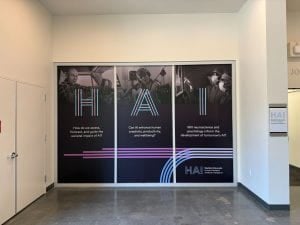 I’m grateful to
I’m grateful to 
 1897 “Curve of Improvement” where people studied productivity in terms of the number of letters people could send per minute… morphing into the number of weeks of practice…
1897 “Curve of Improvement” where people studied productivity in terms of the number of letters people could send per minute… morphing into the number of weeks of practice…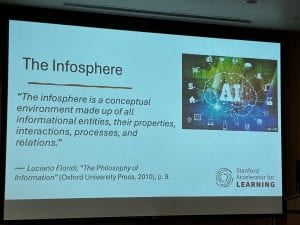 the faculty! We ideated and thought about how we are using AI for Learning – Automation and Efficiency – kids taking speeded tests – no mistakes … scrounging – end of with personalized automated tutors – ONE Trajectory… so many ideas and thoughts … the lectures were great, the preparation was meaningful and we felt highly valued and cared for on our learning visits!
the faculty! We ideated and thought about how we are using AI for Learning – Automation and Efficiency – kids taking speeded tests – no mistakes … scrounging – end of with personalized automated tutors – ONE Trajectory… so many ideas and thoughts … the lectures were great, the preparation was meaningful and we felt highly valued and cared for on our learning visits!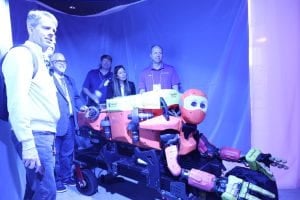
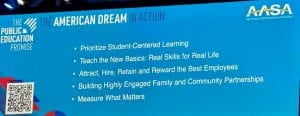
 Administrators. The title and theme was Future Driven Leadership. They announced the Public Education Promise, see images below. There were hundreds of impactful presentations, exhibitors, thought leader sessions, panel discussions, presentations, opportunities for networking and socializing, and more. It’s an annual opportunity for superintendents to recharge their batteries and refuel their leadership toolkits! This year’s conference, my 15th, was powerful and impactful.
Administrators. The title and theme was Future Driven Leadership. They announced the Public Education Promise, see images below. There were hundreds of impactful presentations, exhibitors, thought leader sessions, panel discussions, presentations, opportunities for networking and socializing, and more. It’s an annual opportunity for superintendents to recharge their batteries and refuel their leadership toolkits! This year’s conference, my 15th, was powerful and impactful.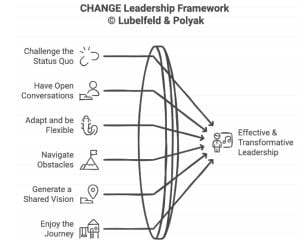




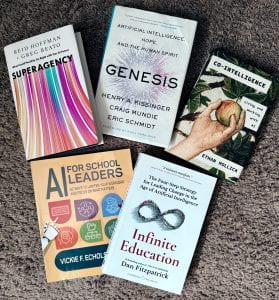 Preparing for 2035: What’s Coming Next?
Preparing for 2035: What’s Coming Next? Another session showed a simple but powerful illustration of education’s trajectory. From 1970 to 2020, progress was steady, linear. But from 2020 to 2022, education was thrown into chaos of COVID disruptions, remote learning, technological acceleration.
Another session showed a simple but powerful illustration of education’s trajectory. From 1970 to 2020, progress was steady, linear. But from 2020 to 2022, education was thrown into chaos of COVID disruptions, remote learning, technological acceleration. Leaps = Structural change (e.g., competency-based, AI-personalized education).
Leaps = Structural change (e.g., competency-based, AI-personalized education). Ensure AI is equitable, closing gaps instead of widening them.
Ensure AI is equitable, closing gaps instead of widening them. New Book Alert!!
New Book Alert!!